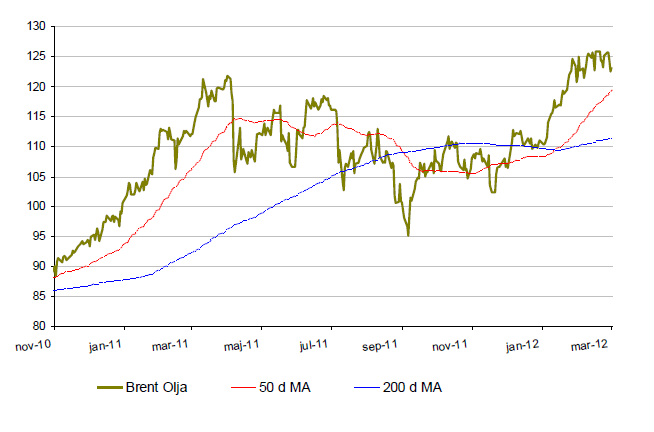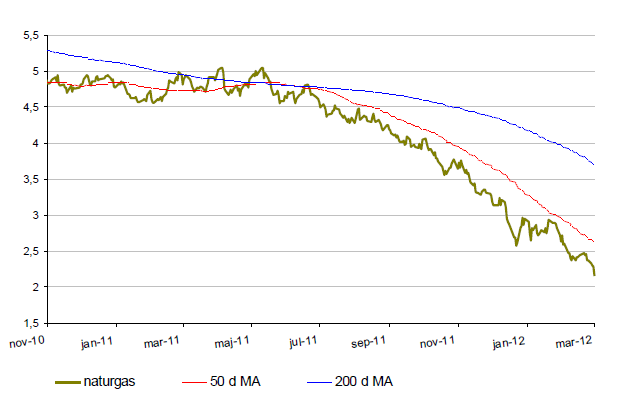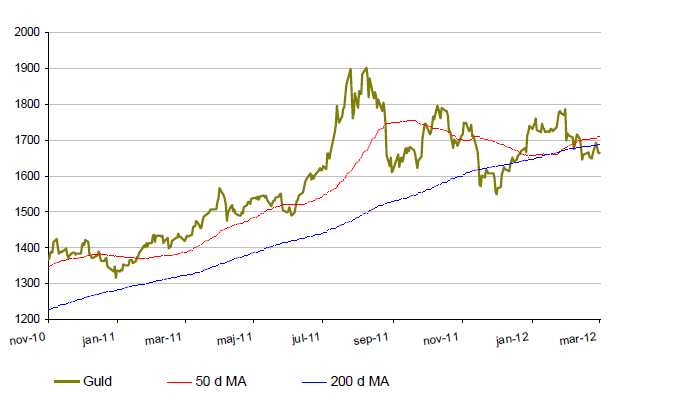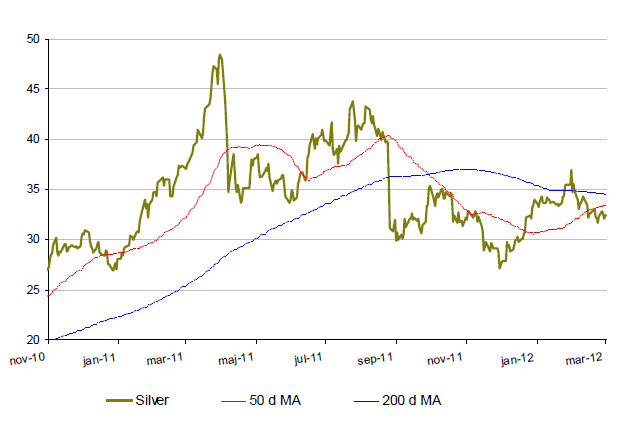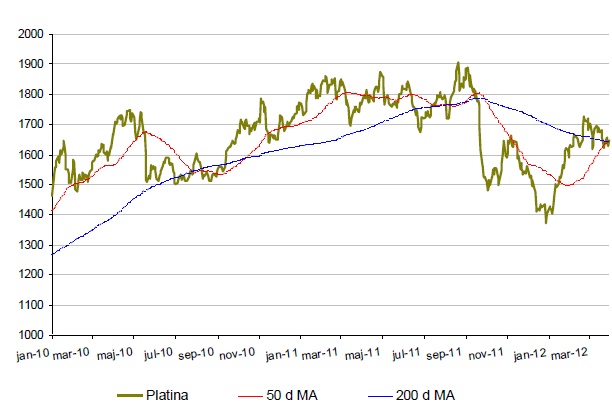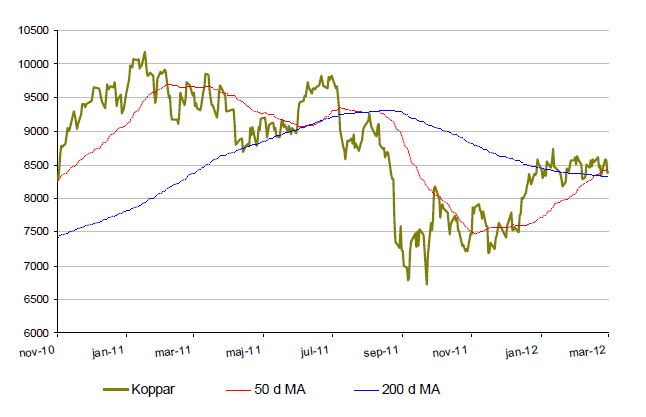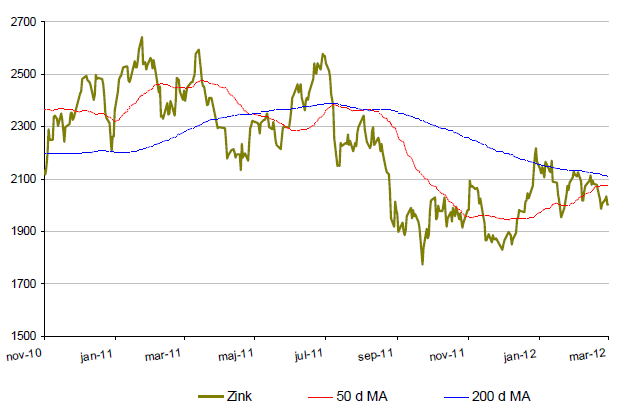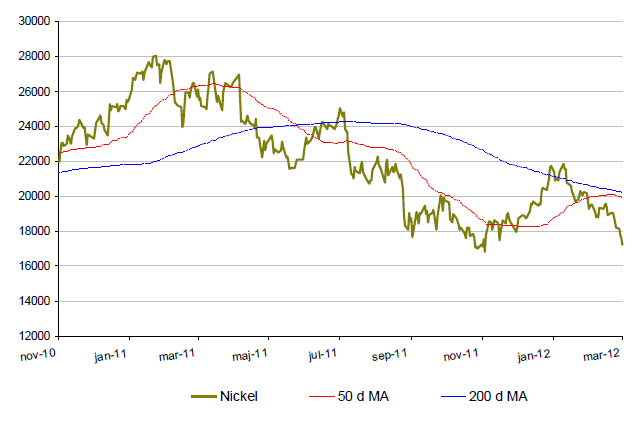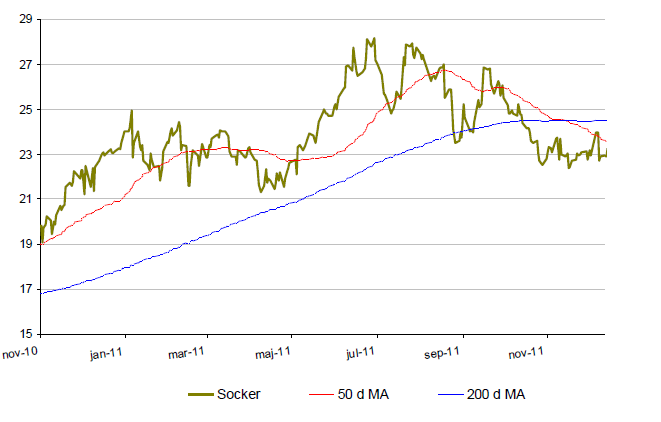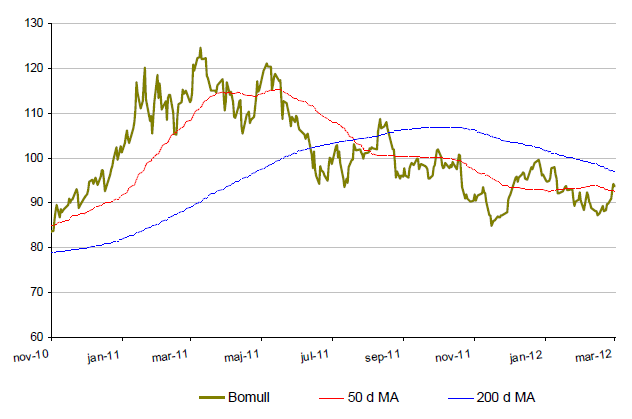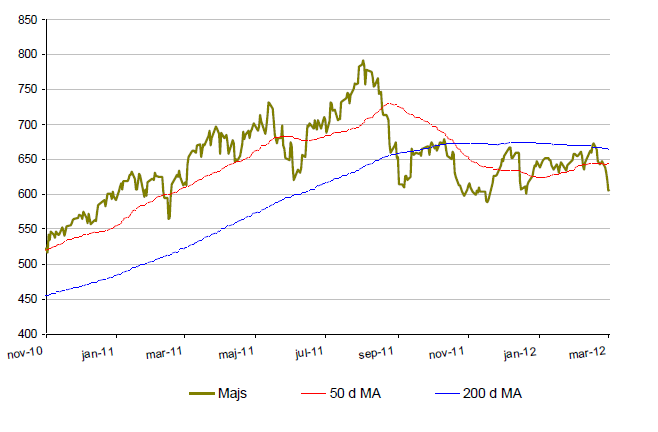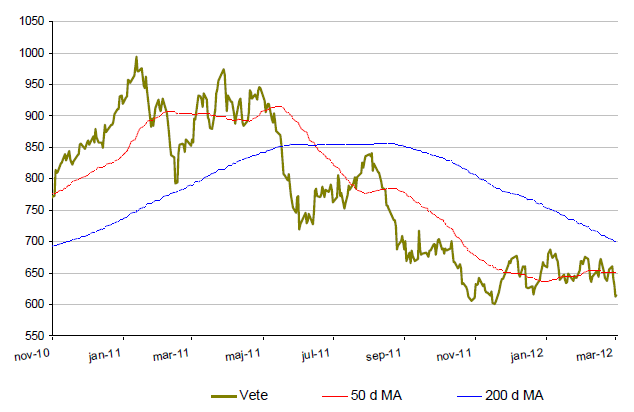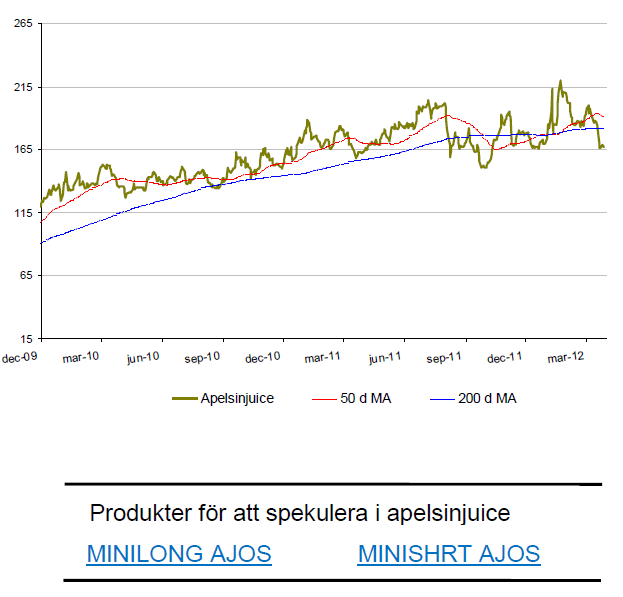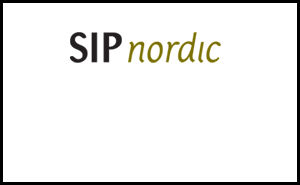Analys
SIP Nordic – Råvaruguiden – April 2012
 Råvaror + aktier blir inte råvaruaktier
Råvaror + aktier blir inte råvaruaktier
Det senaste decenniets uppgång i råvaror har fått investerare att söka sig mot tillgångsslaget. Många vill på något sätt inkludera råvaror i sin portfölj.
Jag är av den tron att en väl sammansatt portfölj bör innehålla en portion råvaror. Hur mycket är upp till var och en att anpassa efter sin riskprofil. Jag anser också att en råvaruexponering bör vara mot råvaror och inget annat. Här skriker nog många till men låt mig förklara.
Det finns många sätt att teoretiskt sett få exponering mot råvaror. Råvaruproducerande länder, såsom Brasilien och Ryssland, kan vara ett sätt att ta del av råvaruprisernas rörelse men det förutsätter ett politiskt, ekonomiskt system som låter intäkterna från råvaror att komma ut i ekonomin. Om detta är verklighet för de två nämnda länderna låter jag vara osagt. Det vanligaste sättet, men också det felaktiga sättet, är investeringar i råvaruaktier. Vad man måste komma ihåg är att investeringar i t.ex. Boliden eller Lundin Mining medför bolagsrisk. Kostnaden för utvinning av många råvaror är i dagsläget mycket högt och pressar vinsterna och lägg också därtill att många råvarubolag verkar i länder med instabila legala system så förstår ni nog var jag vill komma. Råvaruaktier ger, enligt mig, inte en ren exponering mot en viss råvara.
För ett par år sedan stod BP för den största oljekatastrofen i petroleumindustrins historia. Under tre månader flödade olja ut i Mexikanska golfen efter att oljeplattformen Deepwater horizon exploderat. Aktien tappade närmare 60% på väldigt kort tid. Samtidigt som WTI-oljan ”bara” tappade 10%.
Det är en underdrift att säga att den person som investerade i BP för att skapa sig en oljeexponering hade en otrolig otur.
På samma sätt som att oljeinvesteraren hade otur med BP så kan man föra samma resonemang med Lundin Petroleum under hösten 2011. LUPE:s stora fynd av råolja i höstas var för bolaget en supergrej men för brent-oljans pris betydde det ingenting. Oljefyndet skulle räcka till ca 20 dagars global konsumtion.
Det får därmed anses att den person som köpte LUPE för att skapa sig en oljeexponering hade ren och skär bondröta.
Det är viktigt att poängtera att jag inte lägger någon vikt huruvida BP och LUPE är bra bolag som kan genererar avkastning för investeraren. Kontentan är istället att råvaror + aktier inte resulterar i råvaruaktier.
Är ni intresserade av råvaror. Investera då i råvaran och inte aktier.
Råvaror – Energi
Brent olja
- Olja har efter en trevande start i januari både återhämtat sig och nått upp till nya höga nivåer under mars.
- Olja är upp ca.16% upp för året.
- Sedan i början av mars konsoliderar oljan i en kanal mellan 122 och 127 dollar.
- Trots rapporter om ökad tillgång och högre produktion, kyls inte oljepriset ned. Oron i Iran och OPEC länderna bidrar till att oljan behåller sin höga kurs.
- Libyens oljeproduktion börjar smått trappas upp. OPEC ländernas förutspådda produktion för 2012 har däremot sänkts.
Naturgas
- Naturgas närmar sig nu historiskt låga nivåer. Så pass låga att naturgas nu är nere på tio årslägsta.
- De varma temperaturerna i USA vi tidigare skrivit om fortsätter vilket pressar priset på naturgas.
- Naturgas har under året tappat nästan 30%.
- Det låga priset kan tvinga producenter att trappa ned på produktionen vilket kan hjälpa priset på naturgas positivt.
Råvaror – Metaller
Guld
- Summan av världens centralbanker guldpositioner har för första gången på två decennier gått från kort till lång position (spekulerar i uppgång). Detta talar för att guldpriset kan stabilisera sig kring nuvarande nivåer.
- Analytiker tror att centralbankernas guldköp kommer att fortsätta under hela 2012. Totalt räknar analytikerna att centralbanker kommer köpa motsvarande 300 ton guld till under 2012.
- Guld fortsätter att svänga kraftigt men har ökat med ca. 6% för året.
Silver
- Silver har tappat nästan 15% sedan början av Mars men handlas fortfarande på höga nivåer.
- För året är silver upp ca. 19% men har ännu $18 kvar till de höga noteringarna i april förra året.
- Silver befinner sig trots uppgången i en långsiktigt fallande kil.
- Tillgången på fysiskt silver spås minska med 1,5% under 2012 samtidigt som efterfrågan spås öka med 3%
Platina
- Platina har med sin uppgång på ca. 19% för året återhämtat sig rejält och handlas nu på ungefär samma nivåer som guldet.
- Normalt brukar Platinapriset ligga några hundra dollar över guldpriset.
- Strejken i Impala Rustenburg gruvorna i Syd- Afrika, världens största platina gruva, tog slut i mars med det kommer ta tid innan produktionen återgår till det normala.
- Bilindustrin står för den största industriella efterfrågan på platina. Med en stabilare utsikt för bilindustrin följer även högre platinapris.
Koppar
- Koppar har börjat året starkt efter ett ur svagt 2011. Koppar har gått upp ca. 12% i år. (Att jämföra med -21% under 2011)
- Under mars månad har dock kopparpriset stagnerat och konsoliderar nu mellan 8200 och 8750.
- Koppar inventarierna ligger nu på mycket låga nivåer.
- Dagens inventarier räcker enbart i drygt tre veckor. Detta anses oroande då kopparmarknaden behöver en buffert mot produktionsstopp såsom strejken i Freeports gruva i Grasberg i slutet av 2011.
Zink
- Likt koppar har zinkpriset kraftigt stigit under den första månaden av 2012. Zink är upp ca. 7% för året.
- Zinkprisets har dock under mars månad fallit 5% till följd av en mer sund balas i tillgång och efterfrågan.
- Den årliga konsumtionen av zink förväntas växa med 3.6% samtidigt som tillgången bara förväntas växa med 3%. Det uppskattas dock att nuvarande zinktillgång skulle räcka 7,5 veckor, 0,5 veckor längre än 2011.
Nickel
- Nickel presterade sämst av alla basmetaller under 2011.
- Nickel fortsätter sin kräftgång under 2012. Efter en uppgång i januari tappade nickel närmare 18% under februari och mars och är nu den enda basmetallen som inte utvecklats positivt under 2012.
- Produktionen väntas överstiga konsumtionen under 2012.
- Mängden utvunnet nickel förväntas stiga med närmare 10% under 2012.
- Trots att tillgången ökar behöver inte nickelpriset falla. Riskaptiten ökar även bland investerare vilket kan driva råvarupriserna mot högre höjder.
Råvaror – Jordbruk
Socker
- Socker är upp nästan 5% under 2012. Till en följd av dåliga och torra väderförhållandena i världens största sockerproducerande land, Brasilien.
- Det stigande oljepriset har under 2012 driitr sockerpriset uppåt. Då oljepriset ökar ökar även produktionen av etanol, vilket framställs av bland annat sockerrör.
- Sockerpriset hålls dels också kvar på dessa nivåer till följd av en stor order av socker senare i vår. Iran planerar att köpa en stor mängd socker av Indien.
Bomull
- Bomull är för året upp knappa 2%.
- Under 2012 har säljarna kopplat greppet om bomull.
- Det mest troliga att säljarna är i övervikt är att marknadens prognos visar på ett överflöd av bomull och vi ser nu rekordlager av råvaran.
- Viktig nivå för uppgång är $100/lb.
- Extrem torka i USA och ökad efterfrågan av bomullsimport från Kina kompenseras mer än väl av stora skördar i Indien och Brasilien.
Majs
- Prognoser av USDA:s kommande lagerstatistik visar att lagret av majs kommer att sjunka kraftigt.
- USDA justerade, i början av året, ned sin prognos för den Argentinska skörden. Från tidigare 29 miljoner ton till 26 miljoner ton. Nu ser det ut som att dåliga väderförhållanden fortsatt kan sätta käppar i hjulet för den argentinska skörden.
- Majs har för året gått ned nästan 5% och pendlar fortfarande mellan 580 och 680 cent.
Vete
- Likt majs väntar marknaden på USDA:s kommande lagerstatistik.
- Vete har för året gått ned runt 3% till följd av prognoser av bra lagerstatistik men också prognoser av att årets skörd väntas vara av bättre kvalitet än förra året.
- Nettopositionen, dvs summan av köpare och säljare, är fortsatt negativ. Säljarna har alltså fortfarande grepp om vetet.
Apelsinjuice
- Apelsinjuice har under mars månad tappat mer än 11%
- Det finns fortfarande fallhöjd i kursen då apelsinjuice har stigit med nästan 180% sedan 2009.
- Skörden spås dock bli väldigt god i Florida samtidigt som rapporter visar att efterfrågan på apelsinjuice minskar vilken kyler av priset.
- Skörden för året spås bli mycket högre än förra året.
[box]Denna uppdatering är producerat av SIP Nordic och publiceras i samarbete och med tillstånd på Råvarumarknaden.se[/box]
Ansvarsbegränsning
Detta produktblad utgör endast marknadsföring och har sammanställts av SIP Nordic Fondkommission AB.
Innehållet ger inte fullständig information avseende det finansiella instrumentet. Investerare uppmanas att del av prospekt och slutliga villkor, vilka finns tillgängliga på: www.rbsbank.se/markets, innan ett investeringsbeslut tas.
Förekommande exempel är simulerade och baseras på SIP Nordics egna beräkningar och antaganden, en person som använder andra data eller antaganden kan nå andra resultat. Administrativa avgifter och transaktionsavgifter påverkar den faktiska avkastningen.
Analys
More weakness and lower price levels ahead, but the world won’t drown in oil in 2026

Some rebound but not much. Brent crude rebounded 1.5% yesterday to $65.47/b. This morning it is inching 0.2% up to $65.6/b. The lowest close last week was on Thursday at $64.11/b.

The curve structure is almost as week as it was before the weekend. The rebound we now have gotten post the message from OPEC+ over the weekend is to a large degree a rebound along the curve rather than much strengthening at the front-end of the curve. That part of the curve structure is almost as weak as it was last Thursday.
We are still on a weakening path. The message from OPEC+ over the weekend was we are still on a weakening path with rising supply from the group. It is just not as rapidly weakening as was feared ahead of the weekend when a quota hike of 500 kb/d/mth for November was discussed.
The Brent curve is on its way to full contango with Brent dipping into the $50ies/b. Thus the ongoing weakening we have had in the crude curve since the start of the year, and especially since early June, will continue until the Brent crude oil forward curve is in full contango along with visibly rising US and OECD oil inventories. The front-month Brent contract will then flip down towards the $60/b-line and below into the $50ies/b.
At what point will OPEC+ turn to cuts? The big question then becomes: When will OPEC+ turn around to make some cuts? At what (price) point will they choose to stabilize the market? Because for sure they will. Higher oil inventories, some more shedding of drilling rigs in US shale and Brent into the 50ies somewhere is probably where the group will step in.
There is nothing we have seen from the group so far which indicates that they will close their eyes, let the world drown in oil and the oil price crash to $40/b or below.
The message from OPEC+ is also about balance and stability. The world won’t drown in oil in 2026. The message from the group as far as we manage to interpret it is twofold: 1) Taking back market share which requires a lower price for non-OPEC+ to back off a bit, and 2) Oil market stability and balance. It is not just about 1. Thus fretting about how we are all going to drown in oil in 2026 is totally off the mark by just focusing on point 1.
When to buy cal 2026? Before Christmas when Brent hits $55/b and before OPEC+ holds its last meeting of the year which is likely to be in early December.
Brent crude oil prices have rebounded a bit along the forward curve. Not much strengthening in the structure of the curve. The front-end backwardation is not much stronger today than on its weakest level so far this year which was on Thursday last week.

The front-end backwardation fell to its weakest level so far this year on Thursday last week. A slight pickup yesterday and today, but still very close to the weakest year to date. More oil from OPEC+ in the coming months and softer demand and rising inventories. We are heading for yet softer levels.

Analys
A sharp weakening at the core of the oil market: The Dubai curve

Down to the lowest since early May. Brent crude has fallen sharply the latest four days. It closed at USD 64.11/b yesterday which is the lowest since early May. It is staging a 1.3% rebound this morning along with gains in both equities and industrial metals with an added touch of support from a softer USD on top.

What stands out the most to us this week is the collapse in the Dubai one to three months time-spread.
Dubai is medium sour crude. OPEC+ is in general medium sour crude production. Asian refineries are predominantly designed to process medium sour crude. So Dubai is the real measure of the balance between OPEC+ holding back or not versus Asian oil demand for consumption and stock building.
A sharp weakening of the front-end of the Dubai curve. The front-end of the Dubai crude curve has been holding out very solidly throughout this summer while the front-end of the Brent and WTI curves have been steadily softening. But the strength in the Dubai curve in our view was carrying the crude oil market in general. A source of strength in the crude oil market. The core of the strength.
The now finally sharp decline of the front-end of the Dubai crude curve is thus a strong shift. Weakness in the Dubai crude marker is weakness in the core of the oil market. The core which has helped to hold the oil market elevated.
Facts supports the weakening. Add in facts of Iraq lifting production from Kurdistan through Turkey. Saudi Arabia lifting production to 10 mb/d in September (normal production level) and lifting exports as well as domestic demand for oil for power for air con is fading along with summer heat. Add also in counter seasonal rise in US crude and product stocks last week. US oil stocks usually decline by 1.3 mb/week this time of year. Last week they instead rose 6.4 mb/week (+7.2 mb if including SPR). Total US commercial oil stocks are now only 2.1 mb below the 2015-19 seasonal average. US oil stocks normally decline from now to Christmas. If they instead continue to rise, then it will be strongly counter seasonal rise and will create a very strong bearish pressure on oil prices.
Will OPEC+ lift its voluntary quotas by zero, 137 kb/d, 500 kb/d or 1.5 mb/d? On Sunday of course OPEC+ will decide on how much to unwind of the remaining 1.5 mb/d of voluntary quotas for November. Will it be 137 kb/d yet again as for October? Will it be 500 kb/d as was talked about earlier this week? Or will it be a full unwind in one go of 1.5 mb/d? We think most likely now it will be at least 500 kb/d and possibly a full unwind. We discussed this in a not earlier this week: ”500 kb/d of voluntary quotas in October. But a full unwind of 1.5 mb/d”
The strength in the front-end of the Dubai curve held out through summer while Brent and WTI curve structures weakened steadily. That core strength helped to keep flat crude oil prices elevated close to the 70-line. Now also the Dubai curve has given in.

Brent crude oil forward curves

Total US commercial stocks now close to normal. Counter seasonal rise last week. Rest of year?

Total US crude and product stocks on a steady trend higher.

Analys
OPEC+ will likely unwind 500 kb/d of voluntary quotas in October. But a full unwind of 1.5 mb/d in one go could be in the cards

Down to mid-60ies as Iraq lifts production while Saudi may be tired of voluntary cut frugality. The Brent December contract dropped 1.6% yesterday to USD 66.03/b. This morning it is down another 0.3% to USD 65.8/b. The drop in the price came on the back of the combined news that Iraq has resumed 190 kb/d of production in Kurdistan with exports through Turkey while OPEC+ delegates send signals that the group will unwind the remaining 1.65 mb/d (less the 137 kb/d in October) of voluntary cuts at a pace of 500 kb/d per month pace.

Signals of accelerated unwind and Iraqi increase may be connected. Russia, Kazakhstan and Iraq were main offenders versus the voluntary quotas they had agreed to follow. Russia had a production ’debt’ (cumulative overproduction versus quota) of close to 90 mb in March this year while Kazakhstan had a ’debt’ of about 60 mb and the same for Iraq. This apparently made Saudi Arabia angry this spring. Why should Saudi Arabia hold back if the other voluntary cutters were just freeriding? Thus the sudden rapid unwinding of voluntary cuts. That is at least one angle of explanations for the accelerated unwinding.
If the offenders with production debts then refrained from lifting production as the voluntary cuts were rapidly unwinded, then they could ’pay back’ their ’debts’ as they would under-produce versus the new and steadily higher quotas.
Forget about Kazakhstan. Its production was just too far above the quotas with no hope that the country would hold back production due to cross-ownership of oil assets by international oil companies. But Russia and Iraq should be able to do it.
Iraqi cumulative overproduction versus quotas could reach 85-90 mb in October. Iraq has however steadily continued to overproduce by 3-5 mb per month. In July its new and gradually higher quota came close to equal with a cumulative overproduction of only 0.6 mb that month. In August again however its production had an overshoot of 100 kb/d or 3.1 mb for the month. Its cumulative production debt had then risen to close to 80 mb. We don’t know for September yet. But looking at October we now know that its production will likely average close to 4.5 mb/d due to the revival of 190 kb/d of production in Kurdistan. Its quota however will only be 4.24 mb/d. Its overproduction in October will thus likely be around 250 kb/d above its quota with its production debt rising another 7-8 mb to a total of close to 90 mb.
Again, why should Saudi Arabia be frugal while Iraq is freeriding. Better to get rid of the voluntary quotas as quickly as possible and then start all over with clean sheets.
Unwinding the remaining 1.513 mb/d in one go in October? If OPEC+ unwinds the remaining 1.513 mb/d of voluntary cuts in one big go in October, then Iraq’s quota will be around 4.4 mb/d for October versus its likely production of close to 4.5 mb/d for the coming month..
OPEC+ should thus unwind the remaining 1.513 mb/d (1.65 – 0.137 mb/d) in one go for October in order for the quota of Iraq to be able to keep track with Iraq’s actual production increase.
October 5 will show how it plays out. But a quota unwind of at least 500 kb/d for Oct seems likely. An overall increase of at least 500 kb/d in the voluntary quota for October looks likely. But it could be the whole 1.513 mb/d in one go. If the increase in the quota is ’only’ 500 kb/d then Iraqi cumulative production will still rise by 5.7 mb to a total of 85 mb in October.
Iraqi production debt versus quotas will likely rise by 5.7 mb in October if OPEC+ only lifts the overall quota by 500 kb/d in October. Here assuming historical production debt did not rise in September. That Iraq lifts its production by 190 kb/d in October to 4.47 mb/d (August level + 190 kb/d) and that OPEC+ unwinds 500 kb/d of the remining quotas in October when they decide on this on 5 October.

-

 Analys4 veckor sedan
Analys4 veckor sedanVolatile but going nowhere. Brent crude circles USD 66 as market weighs surplus vs risk
-

 Nyheter4 veckor sedan
Nyheter4 veckor sedanAktier i guldbolag laggar priset på guld
-

 Nyheter4 veckor sedan
Nyheter4 veckor sedanKinas elproduktion slog nytt rekord i augusti, vilket även kolkraft gjorde
-

 Nyheter4 veckor sedan
Nyheter4 veckor sedanTyskland har så höga elpriser att företag inte har råd att använda elektricitet
-

 Nyheter4 veckor sedan
Nyheter4 veckor sedanDet stigande guldpriset en utmaning för smyckesköpare
-

 Nyheter3 veckor sedan
Nyheter3 veckor sedanEtt samtal om guld, olja, fjärrvärme och förnybar energi
-

 Analys4 veckor sedan
Analys4 veckor sedanBrent crude ticks higher on tension, but market structure stays soft
-

 Nyheter2 veckor sedan
Nyheter2 veckor sedanOPEC+ missar produktionsmål, stöder oljepriserna




